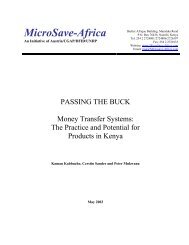Create successful ePaper yourself
Turn your PDF publications into a flip-book with our unique Google optimized e-Paper software.
Many reconstruction<br />
projects required<br />
fast action, and <strong>DAI</strong><br />
fielded “SWIFT”<br />
teams where needed.<br />
The company helped<br />
with elections or<br />
with more basic<br />
needs, such as<br />
infrastructure. This<br />
picture was taken in<br />
Butembo, DRC.<br />
66<br />
In early 1997, rebel troops were marching<br />
toward Kinshasa, the capital <strong>of</strong> Zaire, a<br />
country that would soon regain its historical<br />
name, Congo, or, more formally, the Democratic<br />
Republic <strong>of</strong> the Congo (DRC). The 30-year<br />
dictatorship <strong>of</strong> Mobutu Sésé Seko, whose corrupt<br />
practices and organized thievery gave birth<br />
to the term “kleptocracy,” was rapidly coming<br />
undone. Although Mobutu had been a staunch<br />
ally <strong>of</strong> the United States during the Cold War,<br />
American policy makers were shedding few<br />
tears at his demise, and many were cautiously<br />
Photo by Max Goldensohn, <strong>DAI</strong><br />
optimistic that rebel forces led by Laurent<br />
Kabila might usher in a period <strong>of</strong> stability and<br />
economic recovery. Congo’s massive endowment<br />
<strong>of</strong> mineral wealth and its strategic location<br />
in the heart <strong>of</strong> the continent guaranteed<br />
it would get close attention. No one, however,<br />
could have imagined how much conflict and<br />
pain lay ahead for its people.<br />
Soon after Mobutu fled to exile, Tony Barclay<br />
placed a call to a friend at USAID, asking if<br />
there was a way that <strong>DAI</strong> might assist the<br />
transition and reconstruction process. Rick<br />
Barton, whom he had known for more than<br />
a decade, ran a new, entrepreneurial arm <strong>of</strong><br />
USAID called the Office <strong>of</strong> Transition Initiatives<br />
(OTI), which had been created to deal<br />
with fluid situations like the one unfolding<br />
in Congo. Barton invited Barclay to bring in<br />
a team to meet with his staff in an informal<br />
session, and explained that he was doing the<br />
same with several other prospective partners.<br />
There were many unknowns. <strong>DAI</strong> had cut<br />
its teeth in Congo, learning by doing in the<br />
implementation <strong>of</strong> the North Shaba Rural<br />
Development Project (1977–1986). But the<br />
company had not worked there since. How<br />
bad were conditions across the country, and<br />
how would the Congolese react after their<br />
paternalistic leader disappeared? Were there<br />
viable local organizations to work with? What<br />
were OTI’s expectations <strong>of</strong> an implementing<br />
partner in an environment like this one? Could<br />
<strong>DAI</strong> mobilize the right people and develop<br />
an operating model suited to this challenge?



